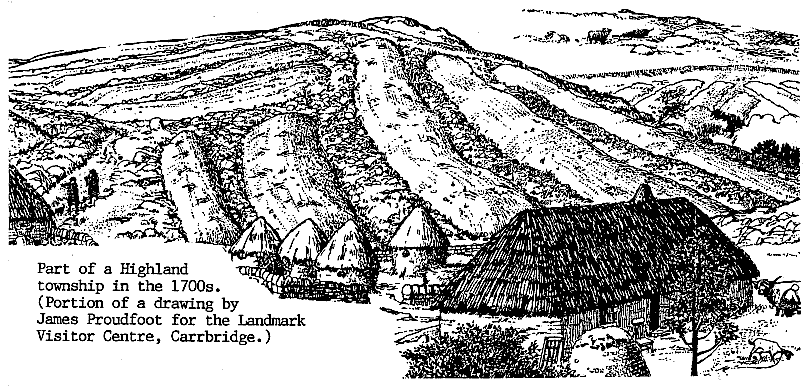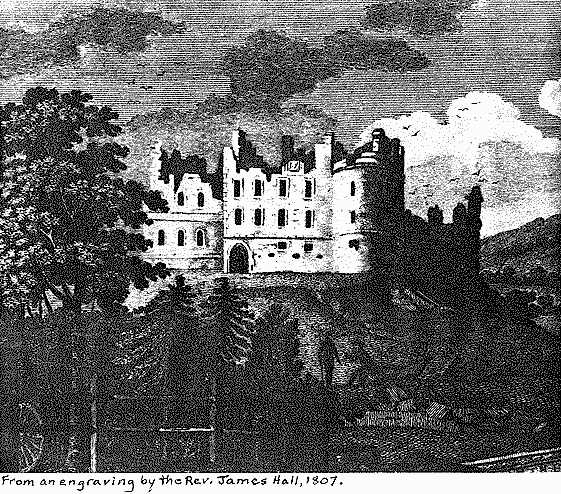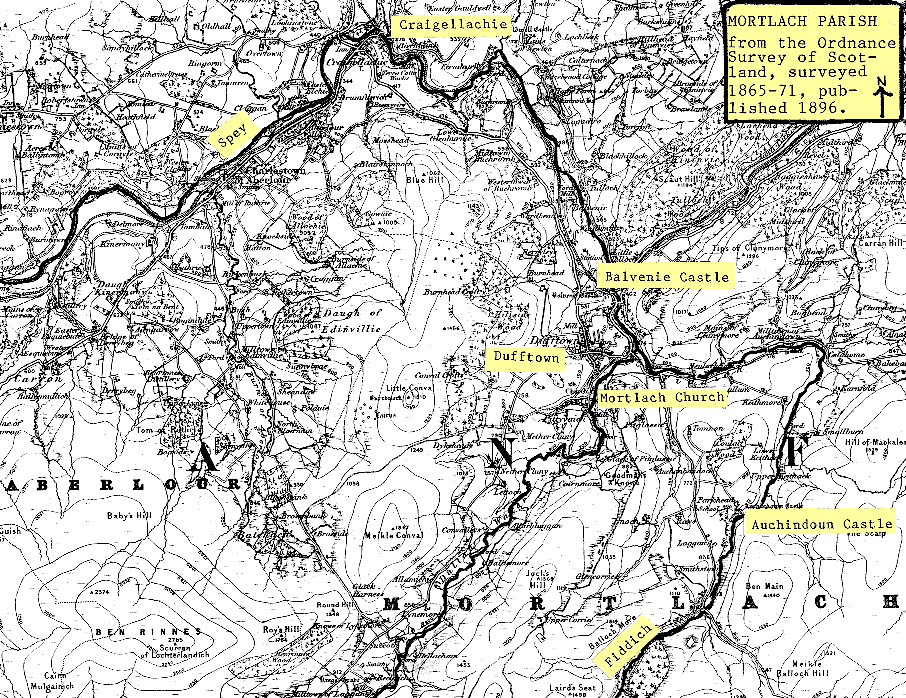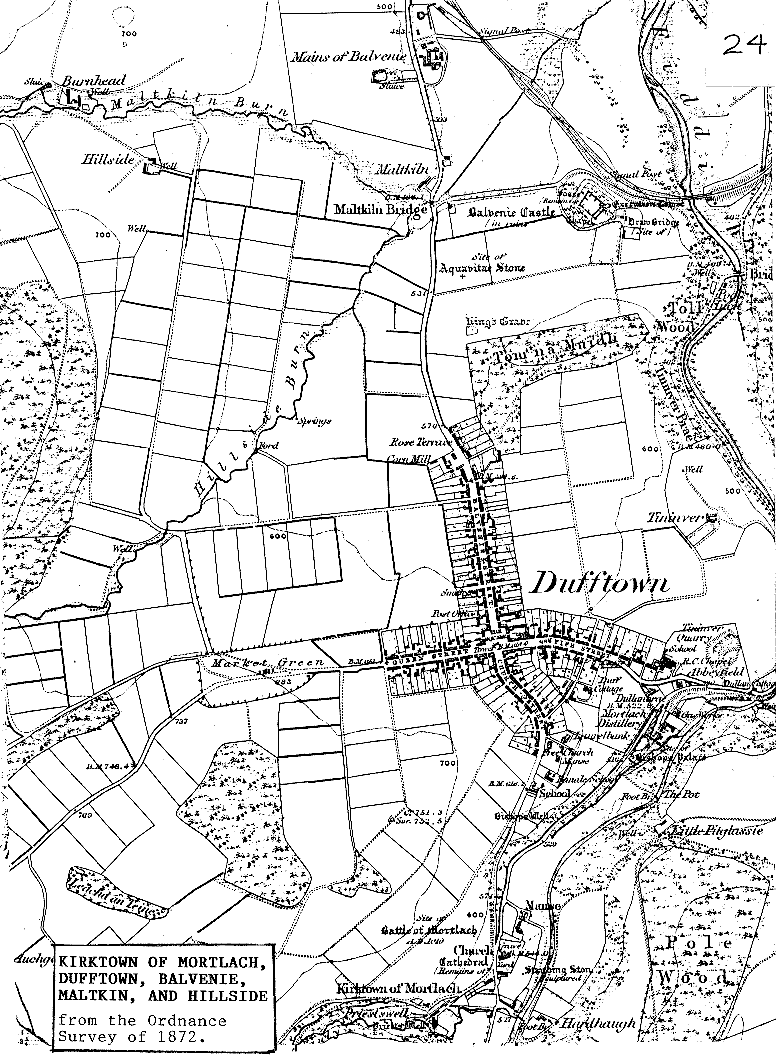

BACKGROUND IN SCOTLANDThe old ways were dying on the farms of Scotland in the early 1800s. Sheep were replacing men. What future did Alexander Stewart, a poor farm boy, have but to become a landless laborer? Where could he find a chance but overseas? Canada called, he answered, and there he made his life -- as a shepherd not of sheep but of men. From time immemorial, until the Agricultural Revolution of the late 1700s and early 1800s, Highland farms were typically rented from the proprietor or landlord by a group of families. Land was held in a system in which it was theoretically owned by God, granted by His representative the Monarch to the church and to important men, and then rented by these Great Landowners to tenants. Several families rented a farm jointly, working the land under the old run-rig (Gaelic "roinn-ruith" = parallel divisions) system. The arable in-field was divided into strips or rigs, rotated among the families, and grew oats, barley, and bere (a primitive barley). The out-field had a rotation of grain and grazing. The so-called "waste" and the hill pastures were used in common. Each family would have an ox or a share in one to contribute to the plough team, perhaps a cow for milk, a few cattle raised for paying the rent, perhaps a Highland pony for the harrow and for transport of grain and hay, a few sheep and goats for milk and wool, and a few chickens and geese. Highlanders did not raise pigs until later. Part of a Highland township in the 1700s.
|

| The staff of life was oats. Also,
each house had a garden for kale and other vegetables. In the 1700s potatoes -- a New
World import -- became another staple, though fortunately not the only one, as in Ireland.
Moors -- the "waste" -- were an essential resource for summer grazing, a scant
bit of winter feed, peat for fuel, heather and reeds for thatch, and wild herbs. Houses were built of stone with earth floors and reed straw, or heather thatch. Since they had no chimneys, only smokeholes, they could be only one storey high. In winter, the cow and sheep came into one end of the house, helping to warm the family in the other end, much like the (larger) farmhouses I have seen in Germany. From the landowners' point of view, the chief product of the land was the men who fought in the seemingly interminable wars of the 1500s and 1600s and the Risings of 1715 and '45. How Alexander Stewart's ancestors fought has not come down to us. After the British government's military occupation of the Highlands in the mid-1700s, the clan chiefs no longer fought against each other and so no longer needed warriors. Instead, they turned to city life and things that cost money. Cash crops were needed. The main one at first was cattle, driven to market in the south. After the Napoleonic Wars were over, cattle prices fell and landowners turned to sheep, the Great Sheep from England, for wool and meat. In the early 1800s, "Improvements" were being adopted in the Highlands to increase production and reduce expenses: turnips for winter feed, scythes and then mowers instead of sickles, threshing machines instead of flails, liming and draining, and a host of other changes that lessened the need for the labor of men, women, and children. The open, jointly leased fields were being enclosed and leased to single tenants (as they had been in previous centuries in England). Rents were being raised. The common lands on which the families of the fermtouns (farm settlements or hamlets) depended were being exploited by the owners for hunting, sheep runs, or commercial forestry plantations. In the early 1800s the land of Scotland was owned by fewer than helf of one percent of the population and many of the families that lived on the land were becoming surplus. LOCATION OF MORTLACH PARISH, BANFFSHIRE, SCOTLAND |

| This was true also of Alexander Stewart's home,
Mortlach parish, Banffshire. Mortlach is in the watershed of the great River Spey which
rushes down from the center of the Highlands to the Moray Firth and the North Sea. The
northern reaches of the Spey roll through coastal lowlands but farther south the watershed
is a high tumble of hills and mountains separating the glens of rivers tributary to the
Spey. One of these is the River Fiddich whose glen forms the eastern part of Mortlach parish. A major tributary of the Fiddich, the Dullan Water, runs through a glen below Ben Rinnes, the highest mountain of the area. Glenrinnes forms the western part of Mortlach parish. The parish, some 11 or 12 miles long and several miles wide, was, until 1817, entirely rural, without a single village. Its agriculture followed the typical Highland pattern. It had a population of 2374 in the mid-1700s but, by the end of the century, it had dropped to 1918. In Alexander Stewart's father's time the land seems not yet to have been cleared for sheep; there were still only about twice as many sheep as people in the parish, the little, fine-haired sheep that were almost like family pets. But, in the early 1800s, change was coming and the rural population of Mortlach parish was falling. One of the five men who owned the land in Mortlach, James Duff, Earl of Fife, decided to found a new village to which some of the surplus people could be removed and perhaps be able to make a living in manufacturing. The village -- which came to be called Dufftown -was started in 1817. Its little thatched stone houses were built on high ground between the old Kirktoun of Mortlach to the south, with its church and two or three houses, and the vacant Balvenie Castle ruins to the north. A few years later, home distillation of whiskey was made illegal; factory distilleries, starting in 1823, became the mainstay of the village. Alexander's father, William Stewart, is said to have once been a fairly well off farmer but to have been a shepherd in lowly circumstances by the time Alexander was born. The boy is said to have grown up on a croft. A croft is a house with a piece of land too small to provide the entire living for the family. The crofter must earn part of his living working for the tenant or others. If William Stewart was reduced from a joint tenant to a crofter, and with crofters being cleared from the land, his children would have seen that they had little prospect in their old home. Historian Marjory Harper writes that
Canada offered these landless Scots land of their own and opportunities unlimited. |
Balvenie Castle in Alexander Stewart's time.

MORTLACH
PARISH, from the Ordnance Survey of Scotland,
surveyed 1865-71, published 1896

KIRKTOWN
OF MORTLACH, DUFFTOWN, BALVENIE,
MALTKILN, AND HILLSIDE, from the Ordnance Survey of 1872

|